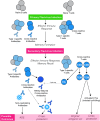Cross-Reactive Immunity Among Flaviviruses
- PMID: 32174923
- PMCID: PMC7054434
- DOI: 10.3389/fimmu.2020.00334
Cross-Reactive Immunity Among Flaviviruses
Abstract
Flaviviruses consist of significant human pathogens responsible for hundreds of millions of infections each year. Their antigenic relationships generate immune responses that are cross-reactive to multiple flaviviruses and their widespread and overlapping geographical distributions, coupled with increases in vaccination coverage, increase the likelihood of exposure to multiple flaviviruses. Depending on the antigenic properties of the viruses to which a person is exposed, flavivirus cross-reactivity can be beneficial or could promote immune pathologies. In this review we describe our knowledge of the functional immune outcomes that arise from varied flaviviral immune statuses. The cross-reactive antibody and T cell immune responses that are protective versus pathological are also addressed.
Keywords: Zika; cross-protection; dengue; flavivirus; tick-borne encephalitis; vector-borne; yellow fever.
Copyright © 2020 Rathore and St. John.
Figures


References
-
- Lindenbach BD, Rice CM. Flaviviridae: the viruses and their replication. In: Knipe DM, Howley PM, editors. Fields Virology. Philadelphia, PA: Lippincott Williams & Wilkins Company; (2001). p. 991–1041.
-
- ICTV. The Online 10th Report of the International Committee on Taxonomy of Viruses. Flaviviridae, Genus: Flavivirus. Available online at: https://talk.ictvonline.org/ictv-reports/ictv_online_report/positive-sen....
-
- De Madrid AT, Porterfield JS. The Flaviviruses (group B arboviruses): a cross-neutralization study. J Gen Virol. (1974) 23:91–6. - PubMed
Publication types
MeSH terms
Substances
LinkOut - more resources
Full Text Sources
Other Literature Sources

